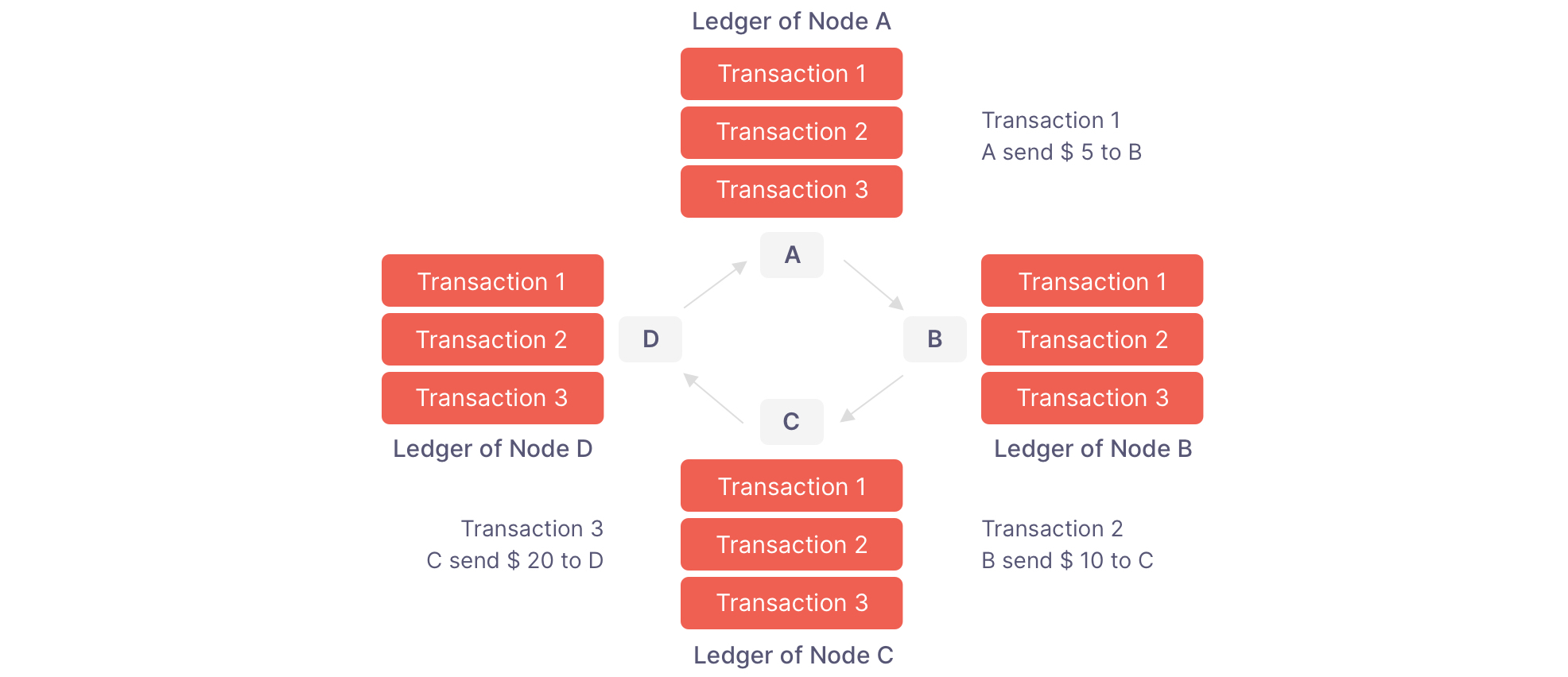Introduction to Blockchain
Blockchain, as the name depicts, is a chain of blocks in which the data is stored and works similarly like the databases. Every next block in the blockchain is connected to the previous block via a cryptographic hash value which tells the block about the previous block. Blockchain is the backbone of all digital currencies, all the transactions made with these digital currencies are saved in the blocks of the blockchain.
Basically, a stream of different nodes constitutes a network of blockchain, and each node comprises a ledger in it. When a transaction occurs, the ledger of all the nodes gets updated. Doesn’t matter which nodes are doing the transactions, the ledger of all the nodes in the network gets updated.In this way, the blockchain works. For example, Bitcoin, a well-known cryptocurrency working these days, working on blockchain. All the transactions of bitcoin are stored in its blockchain, and when some transactions occur between two persons, the ledger of all the nodes in its network gets updated.
Pros & Cons of Blockchain
You have gone through the basics now it’s the right time to start off with the advantages and disadvantages of using blockchain technology.
Pros:
Blockchain technology is the network of decentralized devices. All the nodes in the network contain a copy of the same data. So, all the data of transactions stays resisted, and there would be no possibility of data loss.
If we talk about stability, the data entered in the blocks get checked if the transactions are legitimate or illegitimate. The confirmed block of transactions cannot be reversed. In other words, we can’t make any change or remove that piece of the transaction. Hence, the data stays immutable, which proves the stability of the blockchain.
After consensus from all the network members, the finalized transactions are immutable, and the security of transactions is guaranteed. Not even the system administrator can delete or even change a single transaction.
Before blockchain technology, in the traditional ways of transactions, some intermediaries, like banks, happened to be there. But as we all know that blockchain technology is developed by peer-to-peer connection, there is no need for any intermediary. Hence, it also helped in enhancing financial efficiency.
Cons:
There is also a list of crimes, and heists in cryptocurrencies. Binance, a most famous crypto exchange platform, bore a heist of around 7000 Bitcoins worth $40 Million in 2019. In around 2014, MtGox, which was one of the world’s biggest cryptocurrency exchanges, encountered a heist of an estimated $400 Million worth of bitcoins. After these and some more incidents, it can be stated that the blockchain system has some weak security points that can be covered over time.
Some of the blockchains require so much energy, and Bitcoin’s blockchain is on top of that. An analysis by Cambridge University suggests: “Bitcoin uses more electricity annually than the whole of Argentina.”
Blockchain is sometimes inefficient. For example, if someone wants to make a few transactions per second, the blockchain would perform very well. But if some industry requires thousands, or millions of transactions altogether in a second, the blockchain would not be the best idea to implement. Also, blockchain works in an organization. It doesn’t work in some isolated workplace. So, using it in some isolated situation wouldn’t be a wise choice.
If we talk about the cost and implementation struggle, blockchain is expensive to implement. As we know that the cost of a project varies according to the project’s requirements. But roughly saying, blockchain app development price starts from $5000 and goes up to $200,000.
Also Read: Generations of Blockchain: The Renaissance of Technology and Money
Types of Blockchain
Blockchain is of three types inexact. Below are the types of blockchain:
About Bitcoin Blockchain
The bitcoin blockchain is a public type of blockchain in which the ledger is distributed over the complete network. Everyone in the bitcoin blockchain network has a ledger, and at all the nodes, it gets updated when a transaction occurs. This currency was first invented in 2008 by an unknown person or group of people using Satoshi Nakamoto. The digital currency began to be used in 2009 after its implementation was released as open-source software.
Bitcoin Ledger Distribution
Below is an image illustrating the distribution of the ledger of all the transactions that occurred among the different nodes in a network.
Above the diagram, a transaction of £5 took place from node ‘A’ to node ‘B.’ The ledger of A and B got the transaction data, but the node C and D also updated their ledger. In the same way, transactions occurred between node ‘B’ and node ‘C,’ between node ‘C’ and node ‘D’, and finally between node ‘D’ and node ‘A’. But the main concern is about the updation of the ledger with each transaction. When a transaction occurs between two nodes, the ledger of all the nodes gets updated. This is the beauty of blockchain technology because of this assured data integrity within a network.
Ethereum
Ethereum is the same type of blockchain as bitcoin i.e. distributed, open-source, public blockchain. But the focus of this blockchain is running programming code on the blockchain. It is a blockchain that is not just aimed to enable a digital currency. But it also allows running decentralized applications on different nodes of a network. Ethereum has its native digital currency named Ether and is the second-largest cryptocurrency after Bitcoin.
How Etherum is different from Bitcoin?
Here are some points that differentiate Ethereum blockchain from the Bitcoin blockchain.
- A ‘Smart Contract’ is a piece of code that runs on the nodes of a blockchain network. This code runs only on the Ethereum blockchain and not in bitcoin.
- Ether transactions are confirmed in seconds as compared to minutes for bitcoin transactions.
- For consensus, Ether uses the ‘Ethash’ algorithm while the ‘SHA-256’ algorithm is used by Bitcoin.
- Bitcoin was made in order to replace the physical currency of the country, but Ethereum was mainly built in order to enhance the functionalities of blockchain by introducing programmatic contracts in it.
What are DAPPS?
Decentralized Applications (DAPPS) are the applications developed for running on different nodes of blockchain specifically on Ethereum. We have already talked about Smart Contracts, and DAPPS are the practical examples of these Smart Contracts.
Here are some examples of DAPPS that execute on a decentralized network.
AUGUR:
It is a decentralized application that is built for the foretelling purposes of the stock market. It foretells the price of specific stocks on the basis of information provided by the network.
MELONPORT:
It is also an example of a decentralized application that is aimed to manage digital assets over a network of blockchain.
ETHER TWEET:
A blogging platform like Twitter but is decentralized. The main difference is that in Ether Tweet the posts cannot be deleted just like on Twitter. for more detail Follow my blog with Bloglovin




